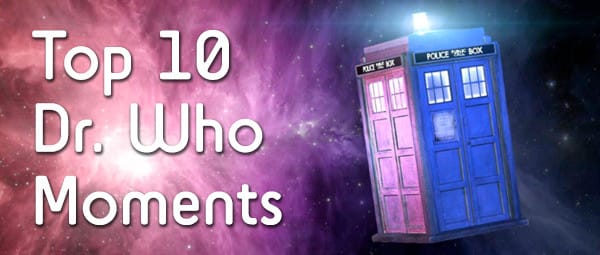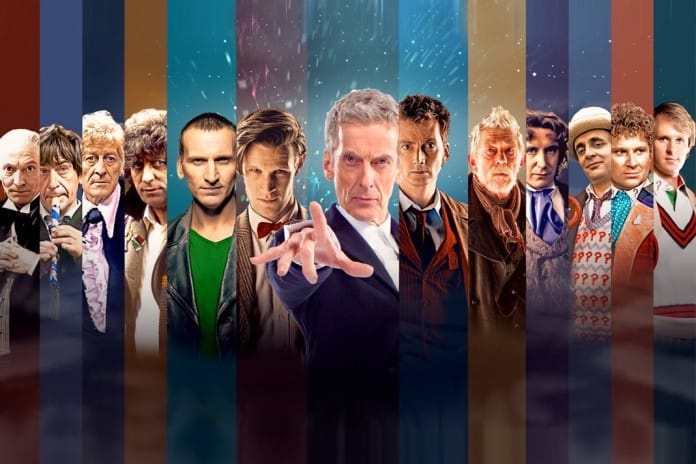
In a series that has been around for over 50 years it’s hard to pick out just ten “top moments,” but having been a massive fan for over 30 years I’m going to do my best… from a non-linear, non-subjective viewpoint of course!
First episode November 23, 1963
The Doctor first appears on British television. Played by William Hartnell, who was best known for portraying army sergeants at the time, he embodied an old man – cantakerous, unsympathetic, and at times ruthless. He came to Earth in his ship called the TARDIS with his granddaughter, Susan, who had enrolled herself at the local Coal Hill School. Her teachers, Ian Chesterton and Barbara Wright, grow concerned when her knowledge of history and science exceeds the other students knowledge and even their own but there are curious gaps in her knowledge of present day culture. They follow her home to an old junk yard at 76 Totter’s Lane where they find a Police box that eminates a faint humming noise and seems to be alive. Pushing their way in after they hear Susan’s voice coming from within, we get our first glimpse of the TARDIS interior and… it’s bigger on the inside! The Doctor explains that they are refugees from another planet and time and tells Ian and Barbara that now that they have discovered their secret he cannot let them go. And thus begins our adventures through time and space!
The first episode drew minimal ratings due to news of John F. Kennedy’s assassination and power outages in many parts of the country so it was repeated again the next week before the airing of the second episode.
Introduction of the Daleks December 23, 1963
The second story of the first season of Doctor Who introduces The Doctor’s greatest nemesis, the Daleks – Once a race of peaceful scientists they became mutated and insanely xenophobic as the product of a nuclear war with the Thals. Powered by static electricity, they were defeated when cut off from their power supply. Brilliant and bent on destroying all other races throughout the universe they would find ways to evolve their power sources to branch out and even invade Earth.
Created by Terry Nation, a writer at the time, they quickly became the most terrifying and iconic villains on the show. This origin would later be retconned in the fourth Doctor story “Genesis of the Daleks.”
First Regeneration October 29, 1966
With William Hartnell’s health failing and the show doing well in the ratings the producers had to come up with a way to keep the show going. Hartnell was becoming increasingly difficult to work with and it was obvious he had to be replaced. An agreement was reached that Hartnell would leave the show, but how would they explain a new actor in the part? Script editor Gerry Davis suggested that since it’s already been established that he’s an alien, why couldn’t he die and appear in a new body? This would allow them to recast the part regularly as necessary. At the end of the serial, “The Tenth Planet” the doctor collapses and mentions his body was “wearing a bit thin” and before his companions eyes, he regenerates into a much younger Doctor played by Patrick Troughton. In his first story, the Second Doctor likens his regeneration to that of a caterpillar turning into a butterfly.
Tom Baker becomes the Doctor December 28, 1974
After Jon Pertwee’s portrayal of the Doctor, ratings were at an all time high. He had played the character for four years, longer than anyone else, and was the most popular Doctor yet. Pertwee would be leaving the show with massive shoes to fill. A man named Tom Baker was recommended to producer Barry Letts by BBC’s Head of Serials. He was working on a construction site at the time as acting jobs were scarce. He was imposingly tall and had a commanding presence and impressed Letts after he had seen him play the villain in The Golden Voyage of Sinbad. Baker would quickly make the part his own with his signature scarf and unpredictable nature and ratings soared even higher. He was by far the most alien Doctor yet and for decades he would be the iconic Doctor, playing the part for seven years, longer than anyone to play the part to date.
Series Cancelled December 6, 1989
Throughout the late 80’s, during the run of the Sixth and Seventh Doctors, the BBC moved the timeslot of the show several times and viewing numbers declined along with public perception of the show. The BBC, after producing the show for 26 seasons, decided to suspend production of the show in-house with plans to find an independent production company to relaunch the show, effectively canceling the series.
TV Movie May 12, 1996
After years in limbo, a joint collaboration between BBC Worldwide, Universal Pictures, 20th Century Fox, and the Fox Network produced a television film as the first attempt to revive Doctor Who and as a pilot for a new American produced series. It introduced Paul McGann as the Eighth Doctor and was a direct continuation of the original series rather than a reboot. It was geared primarily towards American audiences and didn’t fare well in the ratings so no series was commisioned. It was filmed in Vancouver and to this date is still the only Doctor Who filmed in Canada.
Series Reborn March 26, 2005
A new series of Doctor Who begins with the transmission of “Rose” and Christoper Eccleston as the Ninth Doctor. Although the series is clearly a continuation of the original, the BBC treats it as a new show and calls it “Series One.” This made it less daunting for new people to begin watching and perhaps making it easier to market to America. The show had a high budget production which was quite contrary to what fans of the old series were used to seeing. The series won multiple TV Choice and BAFTA awards but it didn’t air for another year in the US due to an initial lack of interest. SyFy aired “Rose” on March 17th 2006. Eccleston only remained on one year as The Doctor for fear of being typecast.
David Tennant December 25, 2005
David Tennant makes his full debut as the Tenth Doctor during the 2005 Christmas special, “The Christmas Invasion.” He is bristling with energy and a stark contrast to Eccleston’s dark, brooding Doctor. He would play the Doctor for 6 years, rivaling Tom Baker for the longest span playing the character. For many American fans he would be their first Doctor and in a 2013 poll in the UK’s Radio Times magazine he was voted the UK’s favorite Doctor.
The Weeping Angels are Introduced June 9, 2007
In the episode “Blink,” writer Steven Moffat introduces a monster for the new age – The Weeping Angels. They are a race of predatory creatures that resemble stone statues. They don’t kill or injure, but send a victim back in time before their birth and feed off the potential energy of the life they would have lived in the present. In the past, the victim is free to live out their lives normally. The Weeping Angels weakness is that while they are being observed by another being they become quantum locked and are unable to move. When they are not being observed, however, they can move quickly and silently.
Doctor Cheats Death December 25, 2013
Every Time Lord is allowed twelve regenerations and by the time of Matt Smith’s departure from the show it was revealed that the Doctor was on his last. We learned through the introduction of John Hurt’s War Doctor in “Day of the Doctor” and when David Tennant’s Meta-Crisis Doctor was revealed to have cost him a regeneration. Gallifrey is lost somewhere in space and time and in his old age, the Eleventh Doctor goes to fight the Daleks one last time at Trenzalore, the prophesized place of his death. His companion, Clara, begs the Time Lords to help the Doctor and they do! A rift in space opens and he is gifted a new set of regenerations! WIth his ages-old enemy defeated, The Doctor sets his sights on a new mission, to find his missing home planet.
This article was written by Billy Bennett, our resident in-house Doctor Who Geek, and edited by Brandon Shoaff, one of our staff writers. Check out all of our awesome Doctor Who Merchandise on SuperHeroStuff.



